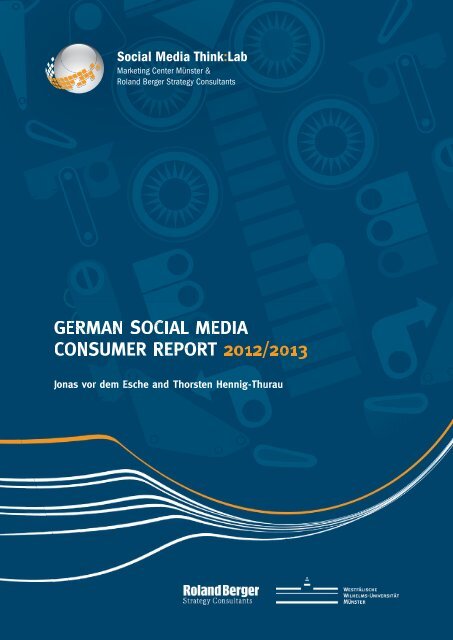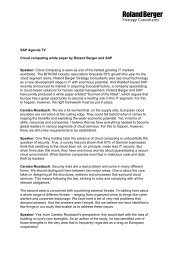German Social Media Consumer Report 2012/2013 - Roland Berger
German Social Media Consumer Report 2012/2013 - Roland Berger
German Social Media Consumer Report 2012/2013 - Roland Berger
You also want an ePaper? Increase the reach of your titles
YUMPU automatically turns print PDFs into web optimized ePapers that Google loves.
GERMAN SOCIAL MEDIA<br />
CONSUMER REPORT <strong>2012</strong>/<strong>2013</strong><br />
Jonas vor dem Esche and Thorsten Hennig-Thurau<br />
Fußzeile<br />
1
FOREWORD<br />
<strong>Social</strong> media are now an integral part of many consumers’ everyday lives. In <strong>2012</strong>, 92.6 % of <strong>German</strong> citizens<br />
with Internet access had at least one social network account. The country-wide acceptance and application of<br />
social media, together with the increasing distribution of smartphones, indicate a fundamental and ongoing<br />
change affecting all elements of the <strong>German</strong> society. The idea of the present study is to protocol this change in<br />
a representative manner. We do so by adopting three unique perspectives:<br />
1. To better understand the basic coordinates of consumers’ social media behavior, we calculate a <strong>Social</strong> <strong>Media</strong><br />
Index and apply it to analyze social media consumption from different demographic and behavioral perspectives<br />
(Section 3).<br />
2. We assess the importance of social media for the consumption of a wide variety of products and services.<br />
We determine the role of social media for purchase decision making and brand relationship formation, two<br />
essential sources of marketing value, by comparing social media with other media in our <strong>Media</strong> Importance<br />
Pie Charts (Section 4 and 5).<br />
3. We take a close look at overall consumer communication behavior in private and business settings, finding<br />
substantive differences between private and business communication practices in <strong>German</strong>y (Section 6).<br />
Essentially, this report provides indisputable evidence that social media have become a key element of <strong>German</strong><br />
consumers’ lives. We believe that several managers today ignore the dramatic dimension of change that social<br />
media bring about for consumers and firms, misjudging social media as just another new communication tool.<br />
The change caused by social media in terms of consumer perceptions and behavior cannot be left to agencies<br />
or social media managers alone, but must be reflected much deeper in company value chains. In this sense,<br />
the present report issues a warning, but also indicates the enormous business potential that the social media<br />
revolution offers to those who are able to act progressively and proactively.<br />
This report was designed and carried out by the <strong>Social</strong> <strong>Media</strong> Think:Lab, a joint research initiative of the University<br />
of Münster’s Marketing Center and <strong>Roland</strong> <strong>Berger</strong> Strategy Consultants. We have established the Think:Lab<br />
to better understand the social media-induced structural changes in society and businesses alike and to offer<br />
companies compelling ways to cope with these changes. Our research projects conform to the methodical and<br />
ethical standards of academic research. We are driven by curiosity and gladly share our research results openly<br />
with all who are also passionate about social media.<br />
In this spirit, we wish you exciting new discoveries while reading!<br />
Jonas vor dem Esche<br />
Research Executive <strong>Social</strong> <strong>Media</strong> Think:Lab<br />
Univ.-Prof. Dr. Thorsten Hennig-Thurau<br />
Academic Director <strong>Social</strong> <strong>Media</strong> Think:Lab<br />
Prof. Dr. Björn Bloching<br />
Partner and Head of Marketing & Sales RBSC<br />
Egbert Wege<br />
Principal RBSC<br />
Dr. Ralf Kiene<br />
Senior Consultant RBSC<br />
3
CONTENTS<br />
1 Executive Summary 6<br />
2 Introduction: Understanding the <strong>Consumer</strong> is Crucial 8<br />
3 The Method: Survey Design 9<br />
3.1 Data Collection 9<br />
3.2 Calculation of the <strong>Social</strong> <strong>Media</strong> Index 11<br />
3.3 Calculation of <strong>Media</strong> Importance Pie Charts for Consumption and Brand Relationships 12<br />
4 The Results: <strong>Social</strong> <strong>Media</strong> Status-Quo 13<br />
4.1 <strong>Social</strong> <strong>Media</strong> Demographics 13<br />
4.2 <strong>Social</strong> <strong>Media</strong> Networks 15<br />
5 The Results: <strong>Social</strong> <strong>Media</strong> and Consumption 18<br />
5.1 General Insights 18<br />
5.2 <strong>Social</strong> <strong>Media</strong> Importance Across Industries 19<br />
5.3 What Drives <strong>Social</strong> <strong>Media</strong> Usage for Purchase Decisions? 21<br />
5.4 What Drives <strong>Social</strong> <strong>Media</strong> Usage for Brand Relationships? 23<br />
5.5 <strong>Consumer</strong> Versus Company-Perceived Importance of <strong>Social</strong> <strong>Media</strong> 25<br />
6 The Results: <strong>Social</strong> <strong>Media</strong> and <strong>Consumer</strong> Communication Habits 27<br />
6.1 General Insights on Private Communication Means 27<br />
6.2 Heavy Versus Low <strong>Social</strong> <strong>Media</strong> Users 27<br />
6.3 Private Versus Business Use of <strong>Social</strong> <strong>Media</strong> 28<br />
7 Conclusion 30<br />
8 References 31<br />
9 Appendix: Industry-specific <strong>Media</strong> Usage Results 32<br />
9.1 Product Industries 32<br />
9.2 Service Industries 37<br />
9.3 Retailing Industries 41<br />
Imprint 44<br />
Contact 45<br />
5
GERMAN SOCIAL MEDIA CONSUMER REPORT <strong>2012</strong> / <strong>2013</strong><br />
1 EXECUTIVE SUMMARY<br />
Our data reveals three major social media-induced<br />
trends in <strong>German</strong> society.<br />
1<br />
For social media, “infancy” is over! In <strong>2012</strong>, social media<br />
became mainstream and are now heavily used by all strata<br />
of the <strong>German</strong> population. No matter what age, educational<br />
background, or income, and no matter where in <strong>German</strong>y<br />
they live, everyone uses social media.<br />
– The average <strong>Social</strong> <strong>Media</strong> Index, which measures social media usage intensity for<br />
<strong>German</strong> citizens is 7.5 (on our scale the daily use of a single social network such<br />
as Facebook warrants 3 points).<br />
– The vast majority of <strong>German</strong>s use social media several times a day.<br />
– <strong>Social</strong> networks vary significantly with regard to the people they attract. On<br />
average, Twitter users are the most active people, whereas Xing users are the<br />
wealthiest – and both networks have the highest educated users.<br />
2<br />
People have started to use social media to improve major<br />
aspects of their daily lives, including those which affect<br />
businesses.<br />
– In <strong>2012</strong>, social media were already as important for consumers’ purchase decisions<br />
in <strong>German</strong>y as TV ads, traditional direct marketing, and public advertising. They<br />
were even more important than radio.<br />
– Over the 19 industries covered by this report, social media influence the purchase<br />
decisions of <strong>German</strong> consumers on average by almost 8 percent.<br />
– The more involved people are in a particular purchase, the more they use social<br />
media.<br />
– On average, social media account for about 6 percent of the development of brand<br />
relationships.<br />
– In private life, social media are the second most important communication medium<br />
for <strong>German</strong> consumers. Only the telephone is (still) more important.<br />
3<br />
Companies have not fully adapted to this change in society yet.<br />
– <strong>German</strong> advertising expenditures still have a considerably skewed distribution,<br />
favoring the established media channels TV and print. Although traditional websites<br />
and social media explain more than 22 percent of <strong>German</strong> consumers’ purchase<br />
decisions, <strong>German</strong> companies currently only spend 12 percent of their advertising<br />
budget on these channels.<br />
– Companies still fail to communicate effectively with consumers through social media.<br />
Currently, 60 percent of <strong>German</strong> consumers cannot see much value in the social<br />
media messages they receive from companies.<br />
– By and large, communication practices vary strongly between private and business<br />
communication. New means of communication and information sharing like social<br />
networks, messenger services, or location-based services are rarely used in <strong>German</strong><br />
companies. Only 3 to 7 percent of <strong>German</strong> employees use these.<br />
6 7
GERMAN SOCIAL MEDIA CONSUMER REPORT <strong>2012</strong> / <strong>2013</strong><br />
2 INTRODUCTION: UNDERSTANDING THE<br />
CONSUMER IS CRUCIAL<br />
These days, social media constitute one of the most prominent challenges for marketing managers. A recent<br />
study by the Marketing Center Münster, which asked 146 <strong>German</strong> managers to name the most important entrepreneurial<br />
challenges over the next few years, finds that 89 % of the respondents name social media. 1<br />
At the same time, we observe that most companies are taking only limited action in response to this enormous<br />
challenge. <strong>Social</strong> media are often treated as merely another communication channel whose value potential is<br />
unclear; companies thus have often limited their response to either doing nothing, hiring a “social media manager,”<br />
or outsourcing social media communication to an agency. A holistic social media strategy that accounts<br />
for the specific characteristics of social media, and at the same time integrates this new channel deeply into<br />
the company’s value chain, is often lacking. This managerial response obviously conflicts with social media’s<br />
perceived importance.<br />
One reason for the lack of far-reaching social media<br />
strategies can be seen in the lack of rigorous scientific<br />
findings or their insufficient diffusion among<br />
managers. The <strong>Social</strong> <strong>Media</strong> Think:Lab team of researchers<br />
has therefore introduced the pinball metaphor<br />
2 as an intuitive model of market dynamics<br />
in the social media era. This model treats modern<br />
marketing as a chaotic but manageable game at a<br />
pinball machine.<br />
In this game, company messages (pinballs) encounter<br />
many very active consumers (bumpers or<br />
slingshots). These consumers then either dramatically<br />
accelerate, transform, or thwart the original<br />
company-message and, by doing so, actively<br />
influence the course of the marketing game. We believe<br />
that in social media times, the pinball model has<br />
succeeded the old, mono-directional and mostly<br />
static model that interpreted marketing as playing<br />
bowling.<br />
This report aims at looking into the black box – the pinball mechanics – by providing reliable data to enhance<br />
our understanding of the central element of the game – the active consumer. How do consumers employ social<br />
media? How closely are social media related to consumers’ purchase decisions and their relationships with<br />
brands? And how does the importance of social media differ between consumers groups, but also between<br />
product markets?<br />
Our approach to take the consumer perspective on social media is not an end in itself, but rather a necessity<br />
for managers to better understand the living environment of their customers. As strong customer orientation<br />
constitutes the backbone of all successful marketing actions. We consider such understanding as essential for<br />
becoming (or remaining) a successful operator of the pinball marketing machine.<br />
3 THE METHOD: SURVEY DESIGN<br />
3.1 Data Collection<br />
The <strong>German</strong> <strong>Social</strong> <strong>Media</strong> <strong>Consumer</strong> <strong>Report</strong> <strong>2012</strong>/<strong>2013</strong> is based on a representative online survey of <strong>German</strong><br />
Internet users who account for 75.6 % 3 of the <strong>German</strong> population. 4 Representativeness refers to gender, age,<br />
education, and provenance within <strong>German</strong>y (federal state and population density); these attributes were used<br />
as quota criteria. Data collection took place during the last two weeks of July <strong>2012</strong>.<br />
The survey consisted of two parts. The first referred to general social media usage and was used to calculate<br />
the <strong>Social</strong> <strong>Media</strong> Index. The second part collected personal and consumption-related information from each<br />
respondent about two consumer industries. A total of 19 product, service, and retail industries were covered by<br />
the survey. The second part yielded the data to calculate the <strong>Media</strong> Importance Pie Charts and to compare the<br />
diffusion of social media for private and business purposes.<br />
In total, we collected 3,236 observations from 1,618 survey respondents (Figure 1). To improve data quality,<br />
we used a conservative approach and excluded all observations for which the processing time from survey respondents<br />
was below a critical threshold, as the short completion time raised concerns about the quality of the<br />
answers of these observations. We also excluded observations which contained patterns. The final dataset consists<br />
of 2,474 observations. Note that the results did not change substantially when including all observations.<br />
Overall, survey respondents considered the questionnaire to be very comprehensible and easy to complete. They<br />
rated its ease of completion at 4.4 on a five-point Likert scale (standard deviation: 0.79).<br />
1 Meffert and Sepehr (<strong>2012</strong>).<br />
2 Hennig-Thurau et al. (2010), Hennig-Thurau, vor dem Esche, and Bloching (<strong>2012</strong>), <strong>Roland</strong> <strong>Berger</strong> Strategy Consultants (<strong>2012</strong>).<br />
3 Statista (<strong>2012</strong>a).<br />
4 Hereafter, the expressions “<strong>German</strong> Internet users”, “<strong>German</strong> population”, and “<strong>German</strong>s” will be used synonymously.<br />
8 9
GERMAN SOCIAL MEDIA CONSUMER REPORT <strong>2012</strong> / <strong>2013</strong><br />
The questionnaire contained cross-sectional data from 19 different product, service, and retail industries (2,474<br />
observations in total). The analyzed industries and the sizes of the respective subsamples are listed in Figure 3.<br />
Figure 1: Data collection statistics.<br />
Accuracy and our use of quotas during data collection led to a favorable distribution of observations in the dataset.<br />
To remove any remaining discrepancies between the sample and the <strong>German</strong> population, we weighted each<br />
respondent so as to obtain an accurate portrayal of the <strong>German</strong> population. As a result of the careful data collection<br />
process, weights were small, ranging only between 0.85 and 1.12 (Figure 2), so that weighting had only a<br />
marginal impact on the results reported in this document. Nevertheless, all results refer to the weighted sample.<br />
Figure 3: Analyzed industries and sample sizes.<br />
3.2 Calculation of the <strong>Social</strong> <strong>Media</strong> Index<br />
In order to measure the status quo of <strong>German</strong> consumer usage of social networks, we developed the <strong>Social</strong><br />
<strong>Media</strong> Index (SMI). The SMI reflects the extent to which consumers in <strong>German</strong>y use social networks. Higher numbers<br />
indicate that consumers register with more social networks or use their current social networks more often.<br />
Specifically, we asked respondents how frequently they use each of their social networks, with answers ranging<br />
from “several times a day” to “at least once a month”. They could choose from a list of the 47 most popular <strong>German</strong><br />
social media platforms. To calculate the <strong>Social</strong> <strong>Media</strong> Index, we summed the social network usage frequency<br />
for each consumer across these 47 social networks. The SMI equals 1 if someone has registered with one social<br />
network and uses it monthly. A value of 2 can be obtained by either the weekly use of a single social network<br />
or by the monthly use of two social networks, and so forth. The theoretical maximum of the index is 188 which<br />
would be reached if a consumer uses all 47 social media platforms several times a day (Figure 4).<br />
Figure 2: Sample description and comparison with <strong>German</strong> population.<br />
Figure 4: The <strong>Social</strong> <strong>Media</strong> Index Scale.<br />
10 11
GERMAN SOCIAL MEDIA CONSUMER REPORT <strong>2012</strong> / <strong>2013</strong><br />
3.3 Calculation of <strong>Media</strong> Importance Pie Charts for Consumption and Brand<br />
Relationships<br />
A major objective of this research was to shed light on the impact of social media information on two key aspects<br />
of consumer behavior, namely purchase decisions and brand relationships. This implies the comparison of<br />
social media information with other more established information sources, including personal face-to-face communication,<br />
but also advertising. To display the perceived importance of all major information sources (including<br />
social media), we produced <strong>Media</strong> Importance-Pie Charts for both purchase decisions and brand relationships.<br />
To create the <strong>Media</strong> Importance Pie Charts, each respondent was asked to name his/her last purchase and his/<br />
her favorite brand for each of the assigned two of 19 industries covered by our survey. This approach was taken<br />
to create a realistic setting. For the last purchase, each respondent rated the importance of different information<br />
sources on a seven-point Likert scale ranging from “not important at all” to “very important”. The importance of<br />
a specific information source was determined through dividing the importance rating for this source by the sum<br />
of all source importance ratings. Figure 5 illustrates this approach and specifies the information sources considered.<br />
Note that to rule out decisions which were based solely on routine and to avoid measurement artifacts,<br />
we restricted answers to products/services the consumer had not purchased before.<br />
Figure 5: Exemplary <strong>Media</strong> Importance Pie Chart for purchase decisions.<br />
4 THE RESULTS: SOCIAL MEDIA STATUS-QUO<br />
4.1 <strong>Social</strong> <strong>Media</strong> Demographics<br />
<strong>Social</strong> media are no longer a phenomenon used only<br />
by a fringe group of highly active Internet users. Our<br />
data reveals that social media have become mainstream<br />
in <strong>German</strong> society. Whether one considers<br />
gender, age, education, or geographical location,<br />
social media have arrived in all classes and strata<br />
of society. The average <strong>German</strong> Internet user 5 is registered<br />
with three (average 3.1; standard deviation<br />
2.9) social media platforms. Only 7.4 % of <strong>German</strong>s<br />
with access to the Internet do not use any social<br />
media platform at all yet (Figure 7). 21.4 % use<br />
only one social media account. However, 21.3 % of<br />
Internet users log into five or more social networks<br />
frequently. Our <strong>Social</strong> <strong>Media</strong> Index (SMI) reveals a<br />
more concise picture of <strong>German</strong> social media usage.<br />
In our representative sample of <strong>German</strong> consumers,<br />
the mean SMI equals 7.5, indicating that the “average”<br />
<strong>German</strong> consumer uses social networks quite<br />
intensively – either by accessing two social network<br />
accounts several times a day, by accessing eight<br />
accounts once a month, or a combination in between –<br />
which is usually the case. The median of the SMI is<br />
six, and the modal value 6 is 4.5.<br />
The non-linear course of the SMI across deciles 7<br />
(Figure 8) reveals that a relatively small group of<br />
consumers uses social media very heavily.<br />
Figure 7: Distribution of the number of social<br />
media accounts (n = 2.474).<br />
The same approach was used for brand relationships (see Figure 6). Here, the questionnaire also included the<br />
respondent’s experience with the product/service, in addition to company sources and traditional forms of personal<br />
communication.<br />
Figure 8: <strong>Social</strong> <strong>Media</strong> Index across sample deciles (n = 2,474).<br />
Figure 6: Exemplary <strong>Social</strong> <strong>Media</strong> Importance Pie Chart for brand relationships.<br />
5 If Section 3 was skipped: Internet users account for 75,6 % of the <strong>German</strong> population (Statista <strong>2012</strong>a). Hereinafter, the expressions<br />
“<strong>German</strong> Internet users”, “<strong>German</strong> population”, and “<strong>German</strong>s” are used synonymously.<br />
6 Modal value: the value that was found most frequently in the sample. 7 Decile: the 10 th , 20 th , 30 th , … percentile in the ranked sample.<br />
12 13
GERMAN SOCIAL MEDIA CONSUMER REPORT <strong>2012</strong> / <strong>2013</strong><br />
Looking at subgroups, males are not significantly more active social media users than females (t-test: t(2.319) =<br />
1.061; p = 0.289). Sorted by age, the most active segment is 16 – 24 years old, followed by the group of 25 – 34<br />
year olds. <strong>Social</strong> media usage decreases in the following segment, but increases somewhat for 45 – 54 year-olds.<br />
The SMI of the 55 – 64 year olds drops off by 33.8 %. However, with an average SMI of 5.2, these older consumers<br />
now also use social media to a substantial degree (Figure 9). This again emphasizes the broad spread of<br />
social media among the different parts of the <strong>German</strong> population.<br />
Average<br />
Subgroups<br />
Figure 10: <strong>Social</strong> <strong>Media</strong> Index for different regional subgroups (n = 2,474).<br />
4.2 <strong>Social</strong> <strong>Media</strong> Networks<br />
Figure 9: <strong>Social</strong> <strong>Media</strong> Index for different demographic subgroups (n = 2,474).<br />
The average <strong>German</strong> consumer is online for two to three hours each day. Only 2.6 % of the <strong>German</strong> population<br />
surf the Internet less than 30 minutes daily, while every fourth <strong>German</strong> spends more than four hours online<br />
(Figure 11).<br />
<strong>Social</strong> media usage is not exclusive to the upper social stratum. On the contrary, people with a “Hauptschul”-<br />
certificate slightly outperform higher levels of education in terms of their SMI. However, this difference is not<br />
statistically significant (t-test between “Hauptschul”-certificate and “Abitur”: t(1.446) = 1.282; p = 0.200). But<br />
compared to consumers with a “Hauptschul”- or “Realschul”-certificate, people with “Abitur” are using social<br />
media less intensively.<br />
Looking at the geographical distribution shown in Figure 10, <strong>German</strong>s from northern federal states (Bundesländer)<br />
are significantly more active in social networks than those living in the south of <strong>German</strong>y (t-test: t(2.409) =<br />
1.974; p = 0.049). Comparing consumers from the east and the west of <strong>German</strong>y, we find no differences between<br />
the eastern states (“Neue Länder”) and the western states (“Alte Länder”). The most social-media-active<br />
federal states are “Nordrhein-Westfalen”, “Brandenburg”, and “Hamburg”; the least active are “Hessen”, “Baden-<br />
Württemberg”, and “Sachsen-Anhalt”.<br />
Similar findings apply to social media usage in urban and rural regions. Again, we could find no significant<br />
differences in SMI between people living in villages or small towns and people living in cities (t-test: t(2.472) =<br />
1.777; p = 0.076).<br />
Ø = Mean; = Standard Deviation from Mean.<br />
Figure 11: <strong>Social</strong> <strong>Media</strong> Index for different regional subgroups (n = 2,474).<br />
Figure 11 also shows that the diffusion of smartphones and tablet computers has created a broad distribution<br />
of secondary devices. More than three quarters (76.4 %) of <strong>German</strong> Internet users surf the net with at least<br />
two Internet-ready devices. Data on mobile Internet access points into the same direction; overall, the average<br />
consumer accesses the Internet in 21.3 % of the cases with mobile devices, which corresponds with an average<br />
mobile usage time of between 25 to 38 minutes each day.<br />
14 15
GERMAN SOCIAL MEDIA CONSUMER REPORT <strong>2012</strong> / <strong>2013</strong><br />
Figure 12 looks at the different social networks. Facebook is by far the largest social media platform in <strong>German</strong>y.<br />
72.1 % of <strong>German</strong> Internet users report that they have a Facebook account. YouTube, the second largest network<br />
among <strong>German</strong> consumers, reaches 38.7 % of <strong>German</strong>s.<br />
Figure 13: Age distribution for leading social networks (n = 2,474).<br />
Figure 12: Most used social media platforms (n = 2,474).<br />
Regarding social media usage intensity, Facebook is closest to the average. This is not surprising, since Facebook<br />
is by far the largest social network and therefore must have patterns comparable to the <strong>German</strong> average. Wer-<br />
Kennt-Wen and YouTube users are slightly more active in social media (<strong>Social</strong> <strong>Media</strong> Indices of 11.9 and 11.5).<br />
We find the most active users on Xing, Google+, and Twitter. Twitter users take the lead with a <strong>Social</strong> <strong>Media</strong> Index<br />
of 17.9, about twice that of the average Facebook user.<br />
We find two more results particularly revealing. Firstly, in just over one year since its launch, Google+ became<br />
the fifth largest social network in <strong>German</strong>y by July <strong>2012</strong>. Secondly, the microblogging network Twitter, which was<br />
long time believed to be only a niche network in <strong>German</strong>y, now holds rank 8. Every tenth <strong>German</strong> Internet user<br />
reports to have a Twitter account.<br />
Facebook, YouTube, Google+, and Twitter are also distinct from other social platforms with respect to frequency<br />
of usage. For all four, more than 40 % of their members report accessing the networks on a daily basis. Here<br />
again, Facebook is at the top with 26.6 % of its users reporting logging in once a day; 50.4 % reporting even<br />
logging in multiple times per day.<br />
How do users differ among social networks? A look at age distribution reveals some interesting differences<br />
(Figure 13). Facebook, YouTube, and Twitter all have a left-skewed distribution, indicating more younger than<br />
older users. The reverse is evident for Wer-kennt-wen. This network has the largest percentage of people aged<br />
35 years or more. Xing and Google+ are in between both groups and yield a bell-shaped age distribution.<br />
These six networks also differ with regard to other criteria, as shown in Figure 14.<br />
Figure 14: Usage intensity for Leading <strong>Social</strong> Networks.<br />
A look at education and income patterns also reveals interesting insights. Xing and Twitter both have the<br />
most educated users, holding an “Abitur” on average. In contrast, Wer-Kennt-Wen users on average own a<br />
“Hauptschul”-certificate. Looking at income, Xing users are the only ones of these six networks with an average<br />
net income of 2,000 – 2,999 Euro, which makes them not only the best educated, but also the top-earning group.<br />
All others share an average income of 1,000 – 1,999 Euro.<br />
16 17
GERMAN SOCIAL MEDIA CONSUMER REPORT <strong>2012</strong> / <strong>2013</strong><br />
5 THE RESULTS: SOCIAL MEDIA AND<br />
CONSUMPTION<br />
5.1 General Insights<br />
Over the last few years, consumer purchase behavior has been constantly changing. For many years now, the<br />
Internet has not only influenced consumer purchase habits, but also how they make purchase decisions. Figure<br />
15 shows the average impact (across all analyzed industries and consumer groups) of key information sources<br />
on consumer purchase decisions of new products (left pie chart) and consumer relationship with their preferred<br />
brand within a given product, service, or retail category (right pie chart).<br />
Purchase Decision Influence Factors<br />
Brand Relationship Influence Factors<br />
The different social media findings for purchase decisions and brand relationships could be attributed to a general<br />
observation we made in our study (and discuss in more detail in Section 6). That is with regard to social media,<br />
companies are still lagging behind private usage. <strong>Consumer</strong>s are able to use social media for purchase decision-making<br />
not because companies have established powerful social media presences, but first and foremost<br />
because of the broad distribution of purchase-related information in the social web from other consumers. Brand<br />
relationships, however, are much more idiosyncratic, requiring a stronger social media engagement by the brand.<br />
This engagement cannot really be outsourced to or compensated for by other consumers’ social media behavior.<br />
The results also reveal that the Internet plays a crucial role for consumer decision making today. Information<br />
from traditional (i.e. non-social media) Internet sites explain 14.7 % of consumers’ average purchase decisions,<br />
which is the strongest media influence factor for purchase decisions of all information sources. Only direct<br />
recommendations from the private sphere of consumers are still more important. The same is true for brand<br />
relationship building, where information from traditional Internet sources accounts for 10.4 % of the brand relationship.<br />
Again, this is the strongest non-personal influence factor for brand relationship formation.<br />
5.2 <strong>Social</strong> <strong>Media</strong> Importance Across Industries<br />
Figure 16 takes a more differentiated look, revealing that the importance of social media information for consumer<br />
decision making differs strongly between industries.<br />
<strong>Social</strong> <strong>Media</strong> Importance per Industry<br />
Figure 15: The role of <strong>Social</strong> <strong>Media</strong> and other information sources for consumer behavior (n = 2,474).<br />
Looking at product or service purchases in <strong>German</strong>y, information from social media is already responsible for 7.6 %<br />
of consumer purchase decisions on average. This is not significantly different to the impact of TV, traditional<br />
direct marketing, and public advertising. 8 <strong>Social</strong> media is significantly more influential than radio for purchase<br />
decisions (Z(2.472) = -10.178; p < .01). According to the respondents in our sample, the most important source<br />
for purchase decisions is still traditional face-to-face recommendation, despite the spreading of social networks.<br />
However, the picture is somewhat different for brand relationships. In this respect, the overall influence of<br />
social media is still relatively small – social media contribute only 5.7 % to the existence of successful brand<br />
relationships. Although this number, being significantly different from zero, clearly points to the relevance of<br />
social media for brand relationships, it also demonstrates that other sources currently play a larger role for consumers;<br />
it is the second weakest source of all information sources. Brand relationships are determined mainly<br />
by consumers’ own usage experiences with a brand (18.7 %), but are also influenced by traditional face-to-face<br />
communication (14.9 %).<br />
Figure 16: The role of social media for purchase decision making across industries. 9<br />
8 We tested whether percentages were different using Wilcoxon tests here and in the remainder of the report. Results: <strong>Social</strong> media and TV<br />
(Z(2.472) = -1.536; p = 0.125), social media and traditional direct marketing (Z(2.472) = -1.526; p > 0.127), social media and public advertising<br />
(Z(2.472) = -0.559; p = 0.576).<br />
18<br />
9 For the number of observations in each industry, please refer to Appendix A.<br />
19
GERMAN SOCIAL MEDIA CONSUMER REPORT <strong>2012</strong> / <strong>2013</strong><br />
<strong>Media</strong> Products, Restaurants, and Online Retailers are each leaders in their particular industry concerning social<br />
media importance for consumer purchase decisions. Not surprising, we observe a general tendency that the more<br />
digital components a product or service has, the more developed the particular industry already tends to be.<br />
Exceptions are high-involvement industries (for further information on the role of consumer involvement for social<br />
media usage, see the next section) and industries in which third-party information providers offer valuable<br />
information. The catering industry is a good example for the latter; except for a few national restaurant chains,<br />
the restaurant market overall is mostly atomistic with many small and independent outlets. Nevertheless, they<br />
are service industry leaders in social media usage for purchase decision-making. This is mainly a result of the<br />
many successful digital restaurant guides like Qype, Yelp, Restaurant-Kritik, Tripadvisor, etc.<br />
5.3 What Drives <strong>Social</strong> <strong>Media</strong> Usage for Purchase Decisions?<br />
We expected consumer involvement with a particular product or service to play a distinctive role in the utilization<br />
of social media, as involvement with a product, service, or retailer should be considered a precondition for social<br />
media engagement. Using an established multi-item involvement measure 10 , our data supports this expectation,<br />
as can be seen in Figure 18, which plots industry involvement against social media impact for purchase decision<br />
making. The figure shows that the more important the purchase for the consumer, the more intensely he/she<br />
uses social media for information purposes before the purchase. An Analysis of Variance 11 provided evidence<br />
that this relationship between involvement and the use of social media for purchase decisions is also highly<br />
significant (F(2,473) = 8.108; p = 0.000).<br />
Figure 17 demonstrates the same industry-level insights for brand relationships. <strong>Social</strong> media are currently most<br />
influential for brand relationship formation for media products, communication services, and the online retailing<br />
industry. However, the differences between them are substantial; for online retailing, social media accounts for<br />
9.4 % of brand relationships, which is almost twice as much as the overall average. The low importance of social<br />
media for restaurants (4.8 %) shows that it is not the companies themselves that impress consumers with<br />
valuable social media content, but rather the independent information providers named above.<br />
A more detailed analysis of each particular industry can be found in the Appendix of this report.<br />
<strong>Social</strong> <strong>Media</strong> Importance per Industry<br />
Figure 18: The link between consumer involvement and social media relevance for purchase decisions.<br />
As people tend to use information from all media types more intensively for high involvement purchases, we<br />
tested whether this result remains when we control for the general increase in information needs for high<br />
involvement products. Specifically, we calculated the relative importance of each information source for each<br />
respondent (by dividing the respondent’s score for social media by the sum of the respondent’s scores for all<br />
kinds of media). Using this relative social media usage values, a second ANOVA could prove that consumer involvement<br />
with a product/service and the use of social media for purchase decisions remains highly significant<br />
(F(2,473) = 2.389; p = 0.001). This means that with an increase in involvement, consumer reliance on social<br />
media increases disproportionately.<br />
Figure 17: The role of social media for brand relationships across industries.<br />
Does the impact of involvement on the usage of social media for purchase decisions remain if other factors are<br />
incorporated as well? And which other factors could that be? To answer these questions, we conducted a stepwise<br />
linear regression to determine whether, in addition to involvement, demographic or behavioral consumer<br />
characteristics provide incremental insights into the importance of social media for purchase decisions. In addition<br />
to these consumer characteristics, we also included industry information 12 to detect additional patterns. The<br />
chosen statistical method – the stepwise regression procedure – is able to autonomously pick from a pool of<br />
variables that particular set of factors which significantly explains characteristics of the dependent variable (here:<br />
social media usage for purchase decisions). Figure 19 shows the statistical results of the regression analysis.<br />
Figure 20 summarizes the main findings.<br />
10 Schneider and Rodgers (1996).<br />
11 ANOVA – A statistical method for testing relationships between variables.<br />
12 Industry information: One dummy variable for each of the 19 industries.<br />
20 21
GERMAN SOCIAL MEDIA CONSUMER REPORT <strong>2012</strong> / <strong>2013</strong><br />
5.4 What Drives <strong>Social</strong> <strong>Media</strong> Usage for Brand Relationships?<br />
Most of the findings reported for purchase behavior also apply to social media and brand relationships. Again,<br />
we first ran an ANOVA to assess the importance of consumer involvement and then calculated a stepwise linear<br />
regression. Figure 21 shows the relationship between respondents’ involvement and their usage of social media<br />
for brand relationships. Again, this relationship is highly significant no matter if we control for the general increase<br />
in involvement (F(2,473) = 1.779; p = 0.022) or not (F(2,473) = 5.046; p = 0.000).<br />
Figure 19: Results of regression analysis to explain social media usage for purchase decisions (n = 2,474).<br />
Figure 21: The link between consumer involvement and social media relevance for brand relationships.<br />
In the regression results reported in Figures 22 and 23, we found that the same consumer characteristics influence<br />
social media usage for brand relationships as for purchase decisions, namely involvement, overall social<br />
media usage (SMI), mobile Internet usage, and income. However, the industries where social media usage is<br />
relevant differ somewhat. For brand relationships, the market seems to be more polarized, because more industries<br />
stand out positively or negatively than in the previous calculation. Online retailers, media products,<br />
entertainment electronics, and the communication services industry already apply social media with positive<br />
effects for brand relationships. By contrast, public utility providers do not yet seem to have established access<br />
to this channel.<br />
Figure 20: Key findings of regression analysis to explain social media relevance for purchase decisions (n = 2,474).<br />
The regression results are in line with our overall social media findings. As a result of the broad distribution<br />
of social media across segments, people with all demographic backgrounds already use this media type for<br />
purchase decisions, so that we find no significant impact of these factors. Only people with a low income tend<br />
to consult social media more often than average. As money is more of an issue for them, purchases need to be<br />
considered more carefully. Looking at industries, only online retailers and media products stand out positively<br />
with regard to social media importance. Concerning hardware products, social media information is currently less<br />
important for decision making.<br />
22 23
GERMAN SOCIAL MEDIA CONSUMER REPORT <strong>2012</strong> / <strong>2013</strong><br />
5.5 <strong>Consumer</strong> Versus Company-perceived Importance of <strong>Social</strong> <strong>Media</strong><br />
Our data also reveals that companies still behave quite backwardly when it comes to marketing expenditure in<br />
new media channels. When comparing <strong>2012</strong> media expenditure figures of <strong>German</strong> companies 13 and purchase<br />
decision influence factors determined in our study, we find a clearly unequal distribution in favor of TV and print<br />
media (see Figure 24). Although Internet presences and social media sites together influence consumer purchase<br />
decision by 22.3 %, <strong>German</strong> companies currently only spend 11.9 % of their advertisement budgets on these<br />
channels. These numbers point at a substantial imbalance in terms of budgeting decisions.<br />
Importance of Information Sources vs. <strong>Media</strong> Expenditure<br />
Figure 22: Results of regression analysis to explain social media relevance for brand relationships (n = 2,474).<br />
* <strong>Media</strong> spending taken from Statista <strong>2012</strong>b.<br />
** Online media spending includes traditional Internet and social media.<br />
Figure 24: Comparison of media expenditure and information source importance.<br />
Figure 23: Key findings of regression analysis to explain social media relevance for brand relation-ships (n = 2,474).<br />
We found interesting consumer patterns when looking at subgroups of our sample which indicate the problematic<br />
nature of this imbalance. Figure 25 shows the distribution of importance of our measured influence factors<br />
for purchase decisions for three consumer groups. The dark gray line belongs to the 20 % of consumers in our<br />
sample who have the lowest <strong>Social</strong> <strong>Media</strong> Index (SMI) values. The graph shows that these people are strongly<br />
influenced by a small number of factors only (i.e., recommendations from friends and family, traditional Internet<br />
content, personal selling, advertisements at point of sale (POS)). In contrast, the dark blue line refers to the 20 %<br />
of people who use social media the most. Their influence pattern for purchase decisions is clearly distinct from<br />
the other group – these consumers tend to balance information from multiple sources when making purchase<br />
decisions. Thus, the influence of a single media source has declined for them, whereas the importance of all<br />
sources in total has increased. From a company perspective, sending consistent messages across all channels is<br />
therefore very important for influencing this group. If we further assume that social media usage will increase in<br />
the future, it is very likely that this segment is about to become more important. We believe the dark blue line<br />
will be the new reality to which advertisers need to adapt.<br />
13 Statista (<strong>2012</strong>b).<br />
24 25
GERMAN SOCIAL MEDIA CONSUMER REPORT <strong>2012</strong> / <strong>2013</strong><br />
Comparison of the Importance of Information Sources for Purchase Decisions for Three <strong>Consumer</strong> Segments<br />
6 THE RESULTS: SOCIAL MEDIA AND<br />
CONSUMER COMMUNICATION HABITS<br />
6.1 General Insights Into Private Communication<br />
Today, social media are firmly anchored in consumers’ daily communication and have assumed an important position<br />
in their everyday lives (Figure 27). On average, social media are already the second most important means<br />
of private communication. 45.1 % of <strong>German</strong>s communicate through social networks on a daily basis. Only the<br />
telephone, with 53.2 % daily usage, is applied more often. Email ranks third and is used daily by 43.4 % of <strong>German</strong><br />
consumers. In contrast, traditional letters and postcards are written daily only by 3.4 % of the population.<br />
Figure 25: Distribution of influence factors for purchase decisions for social media user groups.<br />
In this context, we find it important that consumers are not overly satisfied by the way companies have delved<br />
into the social media realm (see Figure 26). When asking our respondents whether they perceive messages that<br />
companies have sent them via social media as valuable information, about 60 % responded negatively to this<br />
question. Less than 20 % responded positively. Similarly, almost 70 % said that they do not like to communicate<br />
with companies through social media in general, and some 40 % even felt disturbed by company messages.<br />
These numbers indicate that effective social media marketing is a substantial challenge that most companies<br />
still have to learn about and confront.<br />
Question: How often do you use the following media for private communication?<br />
Figure 27: Ranking of communication channels for private communication.<br />
Many developments are being triggered by the increasing popularity of smartphones. For example, the distribution<br />
of smartphones has helped messenger services to gain wide acceptance. As a result, almost every fourth<br />
consumer (24.3 %) uses messengers on a daily basis. The distribution of location-based services (which provide<br />
users with information about their immediate vicinity) is also of interest. Although the majority of consumers<br />
(60.9 %) have not used such offers, every fourth (9.6 %) who has tried them uses them every day.<br />
6.2 Heavy Versus Low <strong>Social</strong> <strong>Media</strong> Users<br />
Figure 26: <strong>Consumer</strong>s’ overall opinion on firms’ social media activities.<br />
How do communication habits differ among consumer types? For our study, we compared the top and bottom 20 %<br />
of social media users (ranked by <strong>Social</strong> <strong>Media</strong> Index) concerning their overall communication behavior. Figure<br />
28 displays the ten most frequently used means of communication of the top 20 % of social media users in our<br />
sample and compares them to the communication habits of the 20 % least active social media users.<br />
26 27
GERMAN SOCIAL MEDIA CONSUMER REPORT <strong>2012</strong> / <strong>2013</strong><br />
Question: How often do you use the following media for private / business communication?<br />
Figure 29: The differential use of communication means in private versus business environments.<br />
Question: How often do you use the following media for private communication?<br />
Figure 28: Different communication habits of top and bottom 20 % of social media users, ranked by <strong>Social</strong> <strong>Media</strong> Index.<br />
The figure shows that heavy social media users are again distinct from other consumers. They have different<br />
communication patterns with respect to all means of communication. The most interesting finding is that without<br />
exception, they use all communication channels far more often than other consumers. Their overall communication<br />
activity across all 13 measured means of communication is 8.5 times higher than the activity of low social<br />
media users. Compared to the sample average, the top 20 % social media users communicate 2.2 times more<br />
often. Not surprisingly, social networks are the most important communication tool for the top 20 % of social<br />
media users, followed by the telephone. Every fourth also uses location-based services (25.7 %). 12.8 % of the<br />
top 20 % of social media users are highly involved in gaming and use ingame communication tools.<br />
6.3 Private Versus Business Use of <strong>Social</strong> <strong>Media</strong><br />
The communication habits of our respondents differ strongly with respect to private and professional environments<br />
(Figure 29). Telephone and email are popular in both worlds, but all other means of communication are used very<br />
differently in the two environments. As a general tendency, considerable skepticism towards modern communication<br />
tools can be observed for business communication. Only 7.1 % of respondents use social networks in their<br />
professional lives on a daily basis, and only 5.5 % of them employ messenger services. The same difference<br />
is found for other modern communication means. Forums, location-based services, video telephony, or microblogging<br />
are all currently used professionally by less than three percent of <strong>German</strong> employees on a daily basis.<br />
These findings raise interesting questions about the reasons for these differences between private and business<br />
communication patterns. We believe two causes are mainly responsible:<br />
Firstly, communication requirements in a business environment are different from those in private settings. This<br />
is true for internal and external communication alike. The market for company-specific internal social networks<br />
is still relatively young and the options for specialized communication software still limited. Some larger <strong>German</strong><br />
companies have started to build their own corporate social networks. However, most <strong>German</strong> enterprises,<br />
especially medium-sized ones, have not entered this area at all yet. Looking at external communication, many<br />
firms fear unqualified statements of their employees both toward the public and toward their customers. To<br />
reduce this risk, the development of social media guidelines and social media training has become popular. This<br />
development, though, is still in its infancy in <strong>German</strong>y. In a recent study by Armutat, Geighardt-Knollmann &<br />
Steinhäuser (<strong>2012</strong>), 66 % of <strong>German</strong> firms had no social media guidelines, and 85 % had not yet offered social<br />
media training for their employees.<br />
Secondly, companies also tend to be slow and riskaverse when it comes to restructuring internal processes. This<br />
might especially be true for modern means of communication. Other studies have shown that in <strong>2012</strong>, 72 %<br />
of <strong>German</strong> companies still restricted social media for their employees somehow, and 9 % of firms even block all<br />
social media applications for all employees. 14 These figures are in line with the results of our study and explain<br />
why 66.2 % of employees have never used social networks and 75.7 % have never utilized messenger services<br />
in their professional lives.<br />
14 Statista (<strong>2012</strong>c).<br />
28<br />
29
GERMAN SOCIAL MEDIA CONSUMER REPORT <strong>2012</strong> / <strong>2013</strong><br />
7 CONCLUSION<br />
8 REFERENCES<br />
For <strong>2013</strong>, many bloggers have predicted the long-awaited fusion of traditional and social media marketing departments,<br />
together with the professionalization of the brand experience via social media. Our data shows that this<br />
step is overdue. For consumers, social media are on the verge of commoditization. Whether for entertainment,<br />
communication, or consumption, this study provides evidence that social media are now used routinely in impressively<br />
many aspects of consumer lives. In the near future, the increasing distribution of smartphones will further<br />
accelerate this development and create many valuable applications for digital, social content in real-world contexts.<br />
Sascha Armutat, Christiane Geighardt-Knollmann, Lena Steinhäuser (<strong>2012</strong>):<br />
DGFP-Kurzumfrage – <strong>Social</strong> <strong>Media</strong> am Arbeitsplatz?, Deutsche Gesellschaft für Personalentwicklung e.V.,<br />
http://static.dgfp.de/assets/empirischestudien/DGFP-Kurzumfrage<strong>Social</strong><strong>Media</strong>.pdf,<br />
page visit from December 28, <strong>2012</strong>.<br />
Thorsten Hennig-Thurau, Edward Malthouse, Christian Friege, Sonja Gensler, Lara Lobschat,<br />
Arvind Rangaswamy, Bernd Skiera (2010):<br />
The Impact of New <strong>Media</strong> on Customer Relationships, Journal of Service Research, 13 (3), 311 – 330.<br />
Hennig-Thurau, Thorsten, vor dem Esche, Jonas, and Bloching, Björn (<strong>2012</strong>):<br />
Flippern statt Bowling – Marketing im Zeitalter von <strong>Social</strong> <strong>Media</strong>,<br />
Marketing Review St. Gallen, vol. 29 (4), pp. 8 – 15.<br />
Meffert, Heribert, Sepeher, Philipp (<strong>2012</strong>):<br />
Marketingdisziplin im Wandel – Empirische Bestandsaufnahme aus Sicht der Wissenschaft und Unternehmenspraxis,<br />
Wissenschaftliche Gesellschaft für Marketing und Unternehmensführung –<br />
working paper no. 213, Backhaus, Klaus, Kirchgeorg, Manfred, Meffert, Heribert (eds.), Münster.<br />
<strong>Roland</strong> <strong>Berger</strong> Strategy Consultants (<strong>2012</strong>):<br />
Changing the Game, think:act CONTENT.<br />
Kenneth C. Schneider, William C. Rodgers (1996):<br />
An ‚Importance‘ Subscale for the <strong>Consumer</strong> Involvement Profile,<br />
Advances in <strong>Consumer</strong> Research, vol. 23, pp. 249 – 254.<br />
In contrast, the average <strong>German</strong> company does not yet seem to have completely adapted to this change. Using<br />
the pinball metaphor of social media marketing, most <strong>German</strong> companies still do not seem to have completely<br />
understood the new rules of the game. Valuable scores in the battle for the consumer favor are still “given away”<br />
because flippers, bumpers, and slingshots are not orchestrated well. From now on, brands need to manage<br />
traditional and social marketing channels jointly, not isolatedly. Our analysis of the top 20 % of social media<br />
users provided a look into future consumer behavior. Already today, many consumers more equally incorporate<br />
information from different sources, for decision making and are frustrated if they cannot find value. As this<br />
consumer segment is likely to grow, it will become more expensive for companies to underuse social media<br />
channels. Marketing needs integrated communication strategies for new and old communication channels to<br />
fully adapt to these new circumstances.<br />
Furthermore, for many companies, it will be worth reconsidering and adjusting CRM-concepts and sales strategies<br />
to extend the integration process beyond marketing as a communication task. Progressive companies will<br />
even go one step further and substantially restructure internal communication processes. They will exploit the<br />
potential offered by more efficient means of communication and collaboration which social media enable – and<br />
some will even allow their employees to use social media on their job …<br />
Statista (<strong>2012</strong>a):<br />
Anteil der Internetnutzer in Deutschland von 2001 bis <strong>2012</strong>, data from TNS Infratest,<br />
http://de.statista.com/statistik/daten/studie/13070/umfrage/entwicklung-der-internetnutzung-in-deutschland-seit-2001/,<br />
page visit from November 26, <strong>2012</strong>.<br />
Statista (<strong>2012</strong>b):<br />
Werbeaufwendungen in Deutschland nach Mediengattungen von Januar bis November <strong>2012</strong><br />
Data from Nielsen <strong>Media</strong> Research,<br />
http://de.statista.com/statistik/daten/studie/189846/umfrage/werbeaufwendungen-in-deutschland-nach-mediengattungen/,<br />
page visit from December 23, <strong>2012</strong>.<br />
Statista (<strong>2012</strong>c):<br />
Wie gestaltet Ihr Unternehmen den Zugang zu <strong>Social</strong> <strong>Media</strong> während der Arbeitszeit?<br />
Data from DGFP,<br />
http://de.statista.com/statistik/daten/studie/151454/umfrage/moeglichkeit-der-nutzung-von-social-media-waehrend-der-arbeitszeit/,<br />
page visit from December 28, <strong>2012</strong>.<br />
These are times of rapid change in which many exciting developments are in store!<br />
30 31
GERMAN SOCIAL MEDIA CONSUMER REPORT <strong>2012</strong> / <strong>2013</strong><br />
9 APPENDIX: INDUSTRY-SPECIFIC MEDIA<br />
USAGE RESULTS<br />
On the following pages, we list the industry-specific results from our study concerning purchase decision influence<br />
factors and brand relationships.<br />
9.1 Product Industries<br />
Overall Results<br />
Number of cases in sample: 1,125 | Average industry involvement: 3.75<br />
Hardware Store Products<br />
Number of cases in sample: 114 | Average industry involvement: 3.66<br />
Purchase Decision Influence Factors<br />
Brand Relationship Influence Factors<br />
Purchase Decision Influence Factors<br />
Brand Relationship Influence Factors<br />
Automotive & Private transportation (bikes, motorcycles, etc.)<br />
Number of cases in sample: 126 | Average industry involvement: 4.83<br />
Home Appliance Industry<br />
Number of cases in sample: 127 | Average industry involvement: 4.23<br />
Purchase Decision Influence Factors<br />
Brand Relationship Influence Factors<br />
Purchase Decision Influence Factors<br />
Brand Relationship Influence Factors<br />
32 33
GERMAN SOCIAL MEDIA CONSUMER REPORT <strong>2012</strong> / <strong>2013</strong><br />
Grocery Industry<br />
Number of cases in sample: 119 | Average industry involvement: 2.42<br />
Apparel Industry<br />
Number of cases in sample: 120 | Average industry involvement: 3.32<br />
Purchase Decision Influence Factors<br />
Brand Relationship Influence Factors<br />
Purchase Decision Influence Factors<br />
Brand Relationship Influence Factors<br />
<strong>Media</strong> Industry (books, movies, music, games, etc.)<br />
Number of cases in sample: 134 | Average industry involvement: 2.88<br />
Sport Goods & Leisure Wear Products<br />
Number of cases in sample: 129 | Average industry involvement: 3.76<br />
Purchase Decision Influence Factors<br />
Brand Relationship Influence Factors<br />
Purchase Decision Influence Factors<br />
Brand Relationship Influence Factors<br />
34 35
GERMAN SOCIAL MEDIA CONSUMER REPORT <strong>2012</strong> / <strong>2013</strong><br />
9.2 Service Industries<br />
Enertainment Electronics Industry<br />
Number of cases in sample: 128 | Average industry involvement: 4.57<br />
Overall Results<br />
Number of cases in sample: 1,073 | Average industry involvement: 3.82<br />
Purchase Decision Influence Factors<br />
Brand Relationship Influence Factors<br />
<strong>Media</strong> Importance for Service Purchase Decisions<br />
Brand Relationship Influence Factors<br />
Furniture & Home Decoration Products<br />
Number of cases in sample: 127 | Average industry involvement: 4.05<br />
Banking & Insurance Industry<br />
Number of cases in sample: 135 | Average industry involvement: 4.34<br />
Purchase Decision Influence Factors<br />
Brand Relationship Influence Factors<br />
Purchase Decision Influence Factors<br />
Brand Relationship Influence Factors<br />
36 37
GERMAN SOCIAL MEDIA CONSUMER REPORT <strong>2012</strong> / <strong>2013</strong><br />
Small Business (barbers, craftsmen, bakeries, etc.)<br />
Number of cases in sample: 126 | Average industry involvement: 3.49<br />
Health Care<br />
Number of cases in sample: 136 | Average industry involvement: 4.08<br />
Purchase Decision Influence Factors<br />
Brand Relationship Influence Factors<br />
Purchase Decision Influence Factors<br />
Brand Relationship Influence Factors<br />
Recreational Services (entertainment parks, cinemas, gyms, etc.)<br />
Number of cases in sample: 135 | Average industry involvement: 3.38<br />
Communication Services<br />
Number of cases in sample: 147 | Average industry involvement: 4.38<br />
Purchase Decision Influence Factors<br />
Brand Relationship Influence Factors<br />
Purchase Decision Influence Factors<br />
Brand Relationship Influence Factors<br />
38 39
GERMAN SOCIAL MEDIA CONSUMER REPORT <strong>2012</strong> / <strong>2013</strong><br />
Travel Industry (providers, airlines, hotels, etc.)<br />
Number of cases in sample: 127 | Average industry involvement: 3.66<br />
Public Utility Services<br />
Number of cases in sample: 130 | Average industry involvement: 4.35<br />
Purchase Decision Influence Factors<br />
Brand Relationship Influence Factors<br />
Purchase Decision Influence Factors<br />
Brand Relationship Influence Factors<br />
Restaurant Industry<br />
Number of cases in sample: 137 | Average industry involvement: 2.83<br />
Purchase Decision Influence Factors<br />
Brand Relationship Influence Factors<br />
9.3 Retailing Industries<br />
Overall Results<br />
Number of cases in sample: 276 | Average industry involvement: 3.20<br />
<strong>Media</strong> Importance for Service Purchase Decisions<br />
Brand Relationship Influence Factors<br />
40 41
GERMAN SOCIAL MEDIA CONSUMER REPORT <strong>2012</strong> / <strong>2013</strong><br />
Offline Retailing<br />
Number of cases in sample: 133 | Average industry involvement: 2.83<br />
<strong>Media</strong> Importance for Service Purchase Decisions<br />
Brand Relationship Influence Factors<br />
Online Retailing<br />
Number of cases in sample: 143 | Average industry involvement: 4.35<br />
<strong>Media</strong> Importance for Service Purchase Decisions<br />
Brand Relationship Influence Factors<br />
42
GERMAN SOCIAL MEDIA CONSUMER REPORT <strong>2012</strong> / <strong>2013</strong><br />
IMPRINT<br />
Publisher:<br />
CONTACT<br />
<strong>Social</strong> <strong>Media</strong> Think:Lab<br />
by Marketing Center Münster and <strong>Roland</strong> <strong>Berger</strong> Strategy Consultants<br />
Am Stadtgraben 13 – 15, 48143 Münster<br />
On behalf of:<br />
Westfälische Wilhelms-Universität (WWU)<br />
Department for Marketing and <strong>Media</strong> Research<br />
Am Stadtgraben 13 – 15, 48143 Münster<br />
and <strong>Roland</strong> <strong>Berger</strong> Strategy Consultants GmbH (RBSC)<br />
Am Sandtorkai 41, 20457 Hamburg<br />
Authors:<br />
Jonas vor dem Esche (WWU)<br />
Phone + 49 251 8325049<br />
jonas.vordemesche@socialmediathinklab.com<br />
Professor Dr. Thorsten Hennig-Thurau (WWU)<br />
Phone + 49 251 8329954<br />
thorsten.hennig-thurau@socialmediathinklab.com<br />
In cooperation with:<br />
Professor Dr. Björn Bloching (RBSC)<br />
Egbert Wege (RBSC)<br />
Dr. Ralf Kiene (RBSC)<br />
We gratefully acknowledge the support of:<br />
Ann-Kristin Knapp (WWU)<br />
Nora Pähler vor der Holte (WWU)<br />
Oliver Eydam (WWU)<br />
Layout: LIVING CONCEPT WERBEAGENTUR GmbH<br />
Images: shutterstock<br />
Copyright: <strong>Social</strong> <strong>Media</strong> Think:Lab <strong>2013</strong> Working Paper Series No. 1<br />
This publication is a scientific research report, which reflects the opinions of the <strong>Social</strong> <strong>Media</strong> Think:Lab at the<br />
time of publication. Although all calculations were conducted as accurately as possible, the publisher cannot be<br />
held responsible for completeness, correctness, or up-to-dateness. Further use of the results remains the reader’s<br />
responsibility. Any and all liability is excluded. All rights, completely or in excerpts, are reserved by the publisher.<br />
Prof. Dr. Thorsten Hennig-Thurau<br />
Director <strong>Social</strong> <strong>Media</strong> Think:Lab<br />
Head of Department of Marketing & <strong>Media</strong> Research, University of Münster<br />
Research Professor in Marketing, Sir John Cass Business School, City University London<br />
thorsten.hennig-thurau@socialmediathinklab.com<br />
Jonas vor dem Esche<br />
Research Executive <strong>Social</strong> <strong>Media</strong> Think:Lab, University of Münster<br />
jonas.vordemesche@socialmediathinklab.com<br />
Prof. Dr. Björn Bloching<br />
Partner and Head of Marketing & Sales CC<br />
<strong>Roland</strong> <strong>Berger</strong> Strategy Consultants GmbH<br />
bjoern.bloching@rolandberger.com<br />
Egbert Wege<br />
Principal, <strong>Roland</strong> <strong>Berger</strong> Strategy Consultants GmbH<br />
egbert.wege@rolandberger.com<br />
Dr. Ralf Kiene<br />
Senior Consultant, <strong>Roland</strong> <strong>Berger</strong> Strategy Consultants GmbH<br />
ralf.kiene@rolandberger.com<br />
44 45
GERMAN SOCIAL MEDIA<br />
CONSUMER REPORT <strong>2012</strong>/<strong>2013</strong><br />
www.socialmediathinklab.com<br />
Fußzeile<br />
46

















